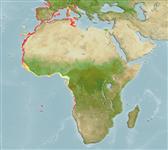>
Pleuronectiformes (Flatfishes) >
Soleidae (Soles)
Etymology: Solea: Latin, solea = sandal (shoe); refered to the flat shape of the fish (Ref. 45335).
More on author: Kaup.
Environment: milieu / climate zone / rango de profundidad / distribution range
Ecología
marino demersal; rango de profundidad 12 - 100 m (Ref. 5304). Tropical; 47°N - 16°S, 19°W - 14°E
Eastern Atlantic: Mainly Central Atlantic (from France to Angola). Western Mediterranean: Herculean migrant (entered the Mediterranean via Gibraltar) (Ref. 43448).
Tamaño / Peso / Age
Madurez: Lm ? range ? - ? cm
Max length : 60.0 cm SL macho / no sexado; (Ref. 5304); common length : 45.0 cm TL macho / no sexado; (Ref. 26999)
Short description
Claves de identificación | Morfología | Morfometría
Espinas dorsales (total) : 0; Radios blandos dorsales (total) : 72 - 95; Espinas anales: 0; Radios blandos anales: 60 - 75; Vértebra: 44 - 46. Last ray of dorsal and anal fins joined by a low membrane to the base of the caudal fin. Supratemporal branch of lateral line forming an arch. Anterior nostril on the blind side not enlarged, its diameter about half that of the eye; it is situated rather close to the front margin of head, the distance slightly greater than that separating the nostril from the mouth cleft, 1:1-1.4. Length of scales above nasal tube on ocular side much less than the length of the tube. Gill rakers like short knobs on first gill arch on ocular side. Pectoral fin on the ocular side with a black botch over the whole middle and distal part of the fin; blind side whitish (Ref. 32649).
Body shape (shape guide): short and / or deep.
Flatfish with oval and asymmetric body (eyes on the right side). Interradial membrane on the pectoral fin on the eye
side is of black colour(A). This feature distinguishes it from common sole (Solea soled), which has a big black compact spot on the posterior side of this fin. In the Atlantic, from the Gulf of Biscay to the coasts of Senegal. Less frequent in the Western Meditarranean.
A predominantly littoral species. Benthonic marine species living in sandy or muddy bottoms, off coastal areas up to
100 m depth and in brackish lakes.Feeds basically on benthonic invertebrate, such as larvae from polychaets and
bivalve molluscs. Also on small crustaceans.Sexual maturity is reached when size is 30 cm. Spawning happens beween the months of March until June. Maximum depth reported taken from Ref. 127989.
Life cycle and mating behavior
Madurez | Reproducción | Puesta | Huevos | Fecundidad | Larva
Desoutter, M., 1990. Soleidae. p. 1037-1049. In J.C. Quero, J.C. Hureau, C. Karrer, A. Post and L. Saldanha (eds.) Check-list of the fishes of the eastern tropical Atlantic (CLOFETA). JNICT, Lisbon; SEI, Paris; and UNESCO, Paris. Vol. 2. (Ref. 5304)
IUCN Red List Status (Ref. 130435: Version 2025-1)
Threat to humans
Harmless
Human uses
Pesquerías: comercial; Acuicultura: experimental
Herramientas
Special reports
Download XML
Fuentes de Internet
Estimates based on models
Preferred temperature (Referencia
123201): 13.6 - 21.6, mean 18.6 °C (based on 46 cells).
Phylogenetic diversity index (Referencia
82804): PD
50 = 0.5020 [Uniqueness, from 0.5 = low to 2.0 = high].
Bayesian length-weight: a=0.00813 (0.00541 - 0.01222), b=3.06 (2.94 - 3.18), in cm total length, based on LWR estimates for this species & Genus-body shape (Ref.
93245).
Nivel trófico (Referencia
69278): 3.3 ±0.45 se; based on food items.
Generation time: 6.2 ( na - na) years. Estimated as median ln(3)/K based on 2
growth studies.
Resiliencia (Referencia
120179): Medio, población duplicada en un tiempo mínimo de 1.4-4.4 años (Preliminary K or Fecundity.).
Fishing Vulnerability (Ref.
59153): Moderate to high vulnerability (49 of 100).
🛈
Climate Vulnerability (Ref.
125649): Moderate vulnerability (43 of 100).
🛈
Nutrients (Ref.
124155): Calcium = 125 [47, 316] mg/100g; Iron = 0.902 [0.386, 1.792] mg/100g; Protein = 17.3 [15.4, 19.2] %; Omega3 = 0.124 [0.066, 0.233] g/100g; Selenium = 29.6 [10.7, 97.8] μg/100g; VitaminA = 11.9 [3.4, 40.5] μg/100g; Zinc = 0.654 [0.349, 1.413] mg/100g (wet weight); based on
nutrient studies.
